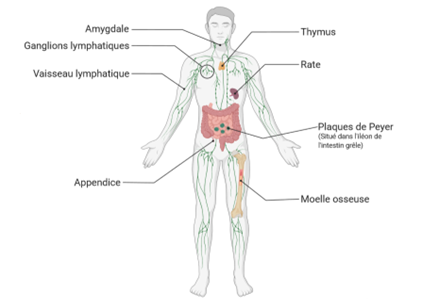FRAIS DE PORT OFFERTS Dès
80€ d'achat
-
 Produits
Produits
-
 Santé
Santé
-
 Sport
Sport
-
 Cuisine saine
Cuisine saine
-
Marques
-
 Les produits Labz
Les produits Labz
- Catégories +
- Les incontournables +
- Vos besoins +
- Tous les produits
- Articulation +
- Beauté +
- Circulation sanguine +
- Concentration +
- Digestion +
- Cardiaque +
- Foie +
- Hormonale +
- Sommeil +
- Stress +
- Immunitaire +
How does our immune system work?
1 - Immunity, booming Interest in the immune system has recently experienced a turning point since the start of the health crisis. The sales are loud and clear on this, dietary supplements grouped in the category of immunity are at the top of the sales. By way of example, here is the turnover achieved in pharmacies (which alone represent 50% of the total sales of food supplements) according to the area targeted by the food supplement (immunity, stress, digestion, etc.).

2 - What is the immune system?
The immune system protects our body against external invaders. These include germs such as bacteria, viruses, and fungi, as well as toxins (chemicals made by microbes). The immune system is made up of different organs, cells and proteins that work together. The study of this immune system is called immunology . The body's ability to defend itself against foreign elements (eg bacteria or viruses) is called immunity. The tonsils, spleen, thymus, lymph nodes and vessels, bone marrow and finally Peyer's patches play several roles in the proper functioning of the immune system. With regard to the appendix, it seems to play a role in this system, in particular as a reserve for the "good bacteria" that make up our intestinal flora.
The tonsils, spleen, thymus, lymph nodes and vessels, bone marrow and finally Peyer's patches play several roles in the proper functioning of the immune system. With regard to the appendix, it seems to play a role in this system, in particular as a reserve for the "good bacteria" that make up our intestinal flora.
3 - Components of the immune system
The immune system consists of two main parts: ➬ The innate immune system ➬ The adaptive immune system These two parts of the immune system work together. A. The innate immune system This system is active and present from birth, so it is immediately put into action without learning. It is non-specific, that is to say that the reaction is the same against the pathogenic agent and it has no memory so the response is not more effective for the same enemy already fought. In this system, there are two successive lines of defense which are not specific. The skin , a physical barrier, prevents the entry of micro-organisms (viruses, bacteria, etc.), and therefore constitutes the first line of defense. There are also the mucous membranes of the gastric, respiratory, genital and urinary tracts which are included in this line of defence. The skin and mucous membranes are also chemical barriers because they produce a substance: mucus. This mucus traps microorganisms to prevent their entry. Nevertheless, these two barriers can be overcome. During a cut, for example, micro-organisms enter the body. From then on, there is the intervention of a second line of defense, which is always non-specific: the inflammatory reaction . The local reaction in the injured area involves chemical signals, antimicrobial proteins and cells with phagocytic actions: neutrophils, namely basophils, eosinophils and neutrophils The inflammatory reaction is triggered by physical trauma (a blow), intense heat, irritation or viral/bacterial infection. Heat, redness, swelling and pain are the four major signs of the inflammatory reaction.
The inflammatory reaction is triggered by physical trauma (a blow), intense heat, irritation or viral/bacterial infection. Heat, redness, swelling and pain are the four major signs of the inflammatory reaction.


 There are two subtypes of this adaptive immunity:
➬ Humoral -mediated immunity where the effectors of this immunity are the antibodies that circulate inside the blood or the lymph.
➬ Cell- mediated immunity involving T cells
To illustrate the delayed and memory phenomenon of adaptive immunity, here is the body's response to exposure to an antigen:
There are two subtypes of this adaptive immunity:
➬ Humoral -mediated immunity where the effectors of this immunity are the antibodies that circulate inside the blood or the lymph.
➬ Cell- mediated immunity involving T cells
To illustrate the delayed and memory phenomenon of adaptive immunity, here is the body's response to exposure to an antigen:
 During the first exposure to an antigen, the organism takes a certain time to recognize and produce the antibodies directed against this antigen. The production of these antibodies is not very strong. On the other hand, during the second exposure to this same antigen, the organism is faster and the response is much stronger.
During the first exposure to an antigen, the organism takes a certain time to recognize and produce the antibodies directed against this antigen. The production of these antibodies is not very strong. On the other hand, during the second exposure to this same antigen, the organism is faster and the response is much stronger.




- Choosing a selection results in a full page refresh.








 Produits
Produits

 Santé
Santé
 Sport
Sport
 Cuisine saine
Cuisine saine
 Les produits Labz
Les produits Labz